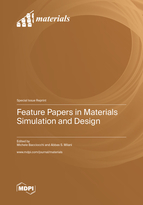Feature Papers in Materials Simulation and Design
A special issue of Materials (ISSN 1996-1944). This special issue belongs to the section "Materials Simulation and Design".
Deadline for manuscript submissions: closed (31 December 2022) | Viewed by 29224
Special Issue Editors
Interests: finite element methods; structural mechanics; plates and beams; numerical analysis; laminated composites; multiphase composites; innovative composite materials; functionally graded materials; carbon nanotubes; non-local theories
Special Issues, Collections and Topics in MDPI journals
Interests: advanced composites manufacturing; Industry 5.0; immersive technology applications; multidisciplinary training
Special Issues, Collections and Topics in MDPI journals
Special Issue Information
Dear Colleagues,
We are pleased to announce this Special Issue entitled “Feature Papers in Materials Simulation and Design” This collection will collect state-of-the-art research work or comprehensive review papers that advance the understanding and prediction of material behavior at scales from atomistic to macroscopic through modeling and simulation. The potential topics include, but are not limited to the following:
- Modeling and/or simulation across materials science that emphasizes fundamental materials issues advancing the understanding and prediction of material behavior.
- Interdisciplinary research that tackles challenging and complex material problems where the governing phenomena may span different scales of material behavior, with an emphasis on the development of quantitative approaches to explain and predict experimental observations.
- Material processing that advances the fundamental materials science and engineering underpinning the connection between processing and properties.
- Homogenization techniques for the evaluation of the mechanical properties of innovative materials and multi-phase composites.
- Development of innovative numerical approaches for the mechanical analysis, highlighting their accuracy, reliability, and stability features.
All articles published in this Special Issue are subject to rigorous peer review and editorial selection. This issue will an ideal forum for disseminating excellent research findings, as well as sharing innovative ideas in the field.
Dr. Michele Bacciocchi
Prof. Dr. Abbas S. Milani
Guest Editors
Manuscript Submission Information
Manuscripts should be submitted online at www.mdpi.com by registering and logging in to this website. Once you are registered, click here to go to the submission form. Manuscripts can be submitted until the deadline. All submissions that pass pre-check are peer-reviewed. Accepted papers will be published continuously in the journal (as soon as accepted) and will be listed together on the special issue website. Research articles, review articles as well as short communications are invited. For planned papers, a title and short abstract (about 100 words) can be sent to the Editorial Office for announcement on this website.
Submitted manuscripts should not have been published previously, nor be under consideration for publication elsewhere (except conference proceedings papers). All manuscripts are thoroughly refereed through a single-blind peer-review process. A guide for authors and other relevant information for submission of manuscripts is available on the Instructions for Authors page. Materials is an international peer-reviewed open access semimonthly journal published by MDPI.
Please visit the Instructions for Authors page before submitting a manuscript. The Article Processing Charge (APC) for publication in this open access journal is 2600 CHF (Swiss Francs). Submitted papers should be well formatted and use good English. Authors may use MDPI's English editing service prior to publication or during author revisions.
Keywords
- processing, bio-based materials, composite materials, carbon fiber, colloidal liquid crystals, etc.
- modeling
- fracture
- durability, characterization, structural analysis
- simulation
- numerical methods
- multi-scale analyses
- homogenization methods








